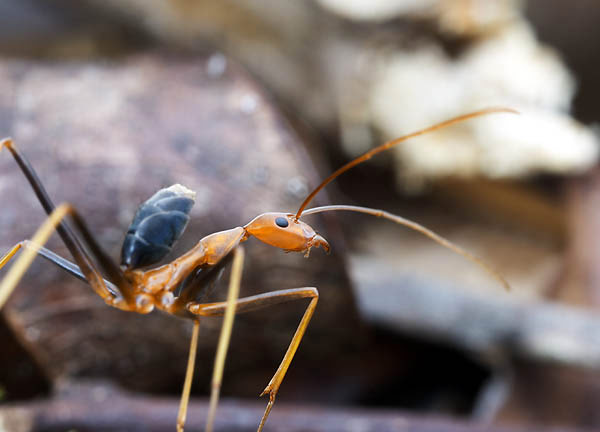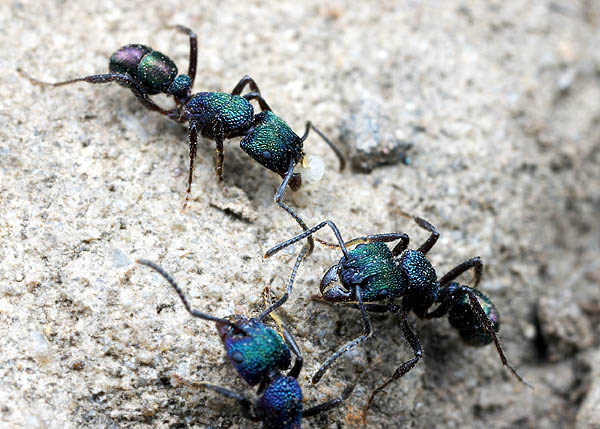Image Gallery: Ants of the World
Brachymyrmex obscurior - Mating Ants

Ants mating. The tiny male is little more than a flying sperm delivery vessel whose life ends shortly after mating. The much larger female will strike out on her own to start a new ant colony. Her bulk is necessary for a life of prolific egg production. Brachymyrmex are some of the smallest ants in the world. They are found throughout the new world but are particularly diverse in the Neotropics.
Myrmecia nigriscapa - Bulldog Ants

A testy bulldog ant advances on the camera that intrudes on her nest. The large eyes of this ant give her excellent vision. Bull ants are well known by Australians for the aggressive defense of their nests and their painful stings.
Myrmecia pilosula - Jack Jumper Ants

Myrmecia ants from neighboring nests, engaged in battle. Jack jumpers are well known by Australians for the aggressive defense of their nests and their painful stings.
Nothomyrmecia macrops - Dinosaur Ants

Nothomyrmecia is among the most elegant of ants. The single species N. macrops is the only living representative of an ancient lineage (the Prionomyrmecini) that occurred worldwide in the Cretaceous. Nothomyrmecia ants are only rarely seen, not because they are uncommon, but because they only forage on cold nights during some parts of the year and because they are restricted to a particular type of mallee habitat.
Oecophylla smaragdina - Green Tree Ants

Oecophyll are large arboreal ants of the African, Asian, and Australian tropics. These conspicuous insects are weaver ants, they create nests by pulling living tree leaves together and securing them with silk produced by the ants' larvae. Colonies can be large and territorial, covering several trees and containing dozens of nests.
Leptomyrmex rufipes - Spider Ants

A spider ant worker, gaster raised characteristically above her body. Leptomyrmex are large, leggy, often colorful insects. Their rapid, skittish movements and their long legs give them a spider-like appearance in the field. Some workers in each nest specialize as living storage containers called repletes, their gasters greatly distended. The extant species of this distinctive genus are restricted to eastern Australia, New Guinea, and New Caledonia.
Pheidole desertorum - Big Headed Ants

Minor workers of Pheidole desertorum tending to eggs and larvae. Pheidole is the world's most species-rich ant genus. They have a cosmopolitan distribution but are particularly diverse in the tropics. Pheidole have a pronounced worker caste polymorphism- major workers are considerably larger than minors and have disproportionately large heads. Some species are seed harvesters.
Get the world’s most fascinating discoveries delivered straight to your inbox.
Formica fusca

Queen and worker Formica ants in the nest, early spring. The fusca group is the most diverse and abundant of all the Formica. They are found nearly everywhere in temperate North America and Eurasia.
Rhytidoponera metallica - Green-Head Ants

Rhytidoponera metallica is a common soil-nesting ant in urban areas throughout Australia. Rhytidoponera are common, conspicuous, and often strikingly-colored ectatommine ants found from Indonesia to Australia and New Caledonia. These ants are encountered in a broad range of habitats and usually nest in the soil or in rotting wood.

